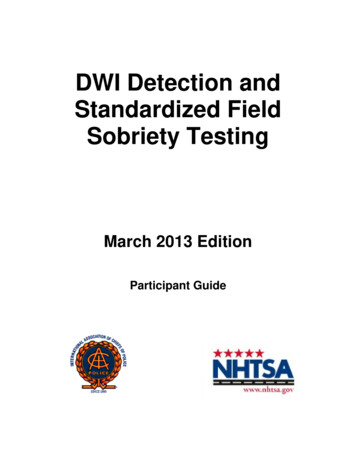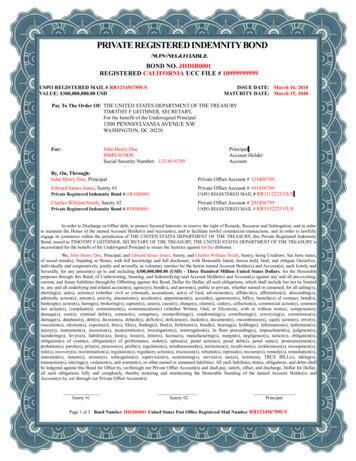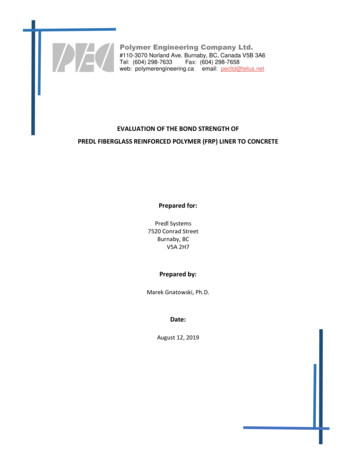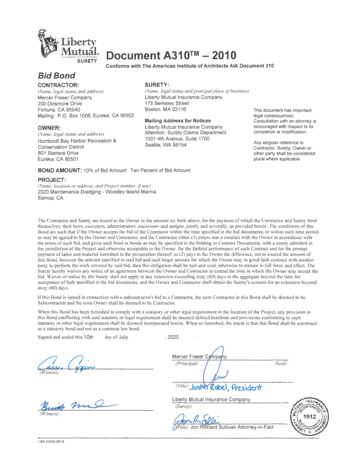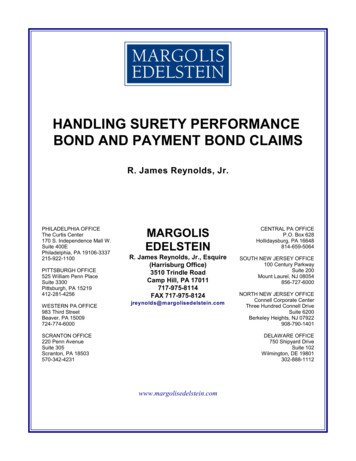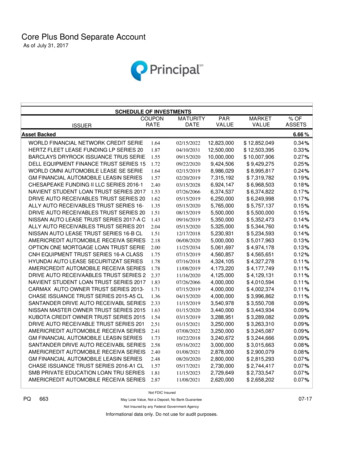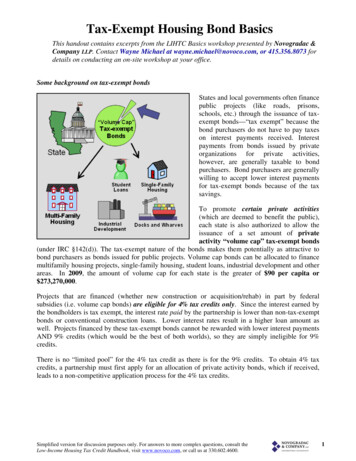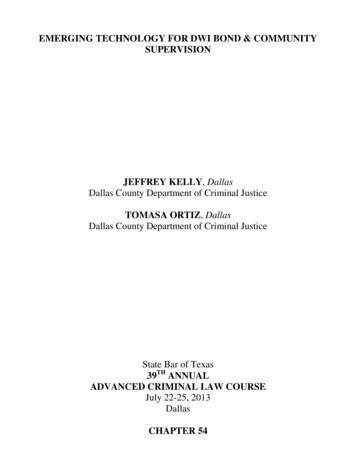
Transcription
EMERGING TECHNOLOGY FOR DWI BOND & COMMUNITYSUPERVISIONJEFFREY KELLY, DallasDallas County Department of Criminal JusticeTOMASA ORTIZ, DallasDallas County Department of Criminal JusticeState Bar of Texas39TH ANNUALADVANCED CRIMINAL LAW COURSEJuly 22-25, 2013DallasCHAPTER 54
JEFFERY P. KELLYJeff Kelly is currently a Bond Supervision Officer working for the Dallas County Department of CriminalJustice at the Frank Crowley Courthouse in Dallas. He is one of two officers in the Bond Supervision Unit, whichsupervises an average of 950 DWI cases per month.He graduated from Kellogg College in Battle Creek, MI, with an Associates’ Degree in BusinessAdministration in 1999. After that, he graduated from Western Michigan University in Kalamazoo, MI with aBachelors’ Degree in Business Management in 2001. Mr. Kelly is currently enrolled in the Fast Track program at theUniversity of Texas @ Dallas, and will complete a Bachelors’ Degree in Criminology in the fall. He will complete aMasters’ Degree in Criminology in the Fall of 2014, and is an active member of Alpha Phi Sigma, the honors societyfor Criminal Justice and Criminology students.The day after his high school graduation, Jeff joined the United States Army where he was eventuallyselected for Ranger training. After successfully completing the rigorous training program, he joined the elite unitknown as 1st Ranger Battalion, 75th Ranger Regiment. Beginning as a Heavy Weapons specialist, Mr. Kellyeventually became a Gun Team Leader, achieving the rank of SGT E-5. He successfully completed Sniper School,Scout Swimmer School, Ranger school, Airborne School, SEAR School. He earned several accommodations duringhis military career, including two Purple Hearts, the Army Accommodation Medal and the Army AchievementMedal. He also earned British Parachute Wings while training with the British SAS and Belgian Parachute Wingswhile training with the Belgian Special Forces.After leaving the military, Mr. Kelly spent the next fifteen years working in automotive manufacturing,working as a supervisor and eventually becoming a quality manager. Deciding to relocate to a warmer climate, Mr.Kelly and his wife moved to Texas in 2007. Some of his hobbies include working out, playing softball and golf,marksmanship, riding motorcycles and spending time with his family pets.
TOMASA ORTIZMs. Ortiz currently works alongside Mr. Kelly in the Bond Supervision Unit for Dallas County.She began her college education in Mountain View College, located in Dallas. Upon completing her basiccoursework, she transferred to the University of North Texas- Dallas Campus. In 2011, Ms. Ortiz earned a Bachelors’Degree in Criminal Justice. She is currently enrolled in the masters’ program at Walden University. She willcomplete a Masters’ degree in Forensic Psychology in the Fall of 2014.While attending school, she worked at Wal-Mart as a Customer Service Supervisor. Recognizing her interestin law enforcement, the retail industry was not a long term selection. Upon receiving her degree, she began workingas a Juvenile Detention Officer at the Henry Wade Juvenile Justice Center. In pursue of a position with greaterimpact on individuals prior to their incarceration, Ms. Ortiz left the juvenile department in order to accept anopportunity as a Case Manager with Sentinel Offender Services. Sentinel provides multiple services includingelectronic monitoring, alcohol monitoring, and urinalysis screening for defendants in several jurisdictions, includingDallas County. Having worked closely with the Jail Diversion Programs in Dallas County, Ms. Ortiz was recruitedby Management to assist in the transition and improvement of the Bond Supervision Department. Recognizing herattention to detail, focus and the ease of which she maintains officer presence, she was hired as a Bond SupervisionOfficer.Ms. Ortiz has been an extremely valuable asset to her department, and helped transform the culture of theBSU to a more professional environment. She has personally implemented several process improvements and helpedthe department set records for client collections and efficiency. Her hobbies include spending time with her family,working out and watching crime dramas on television.
Emerging Technology for DWI Bond & Community SupervisionChapter 54TABLE OF CONTENTSTEXAS STATUTE CHAPTER 49.00 INTOXICATION AND ALCOHOLIC BEVERAGE OFFENSES . 1BOND SUPERVISION POLICIES . 2STATS . 2NEW TECH . 2COMMON LAWYER MISCONCEPTIONS ABOUT INTERLOCKS . 4OFFENDER ISSUES . 4i
Emerging Technology for DWI Bond & Community SupervisionChapter 54EMERGING TECHNOLOGY FOR DWI BOND & COMMUNITY SUPERVISIONTEXAS STATUTE CHAPTER 49.00 INTOXICATION AND ALCOHOLIC BEVERAGE OFFENSES49.04 DWI 1st Class B Misdemeanor Interlock not required – BAC over .15 – Interlock MAY be required by theMagistrate or presiding Judge.DWI 2nd – Class A Misdemeanor – Interlock required (49.09 Enhancements)DWI 3rd or More – 3rd Degree Felony – Interlock required (49.09 Enhancements)49.045 DWI w/ Child Younger than 15 – State Jail Felony – Interlock required49.05 Flying While Intoxicated49.06 Boating While Intoxicated49.07 Intoxication Assault – 3rd Degree Felony – Interlock required49.08 Intoxication Manslaughter – 2nd Degree Felony – Interlock requiredTEXAS CODE OF CRIMINAL PROCEDURE – ARTICLE 17.441 CONDITIONS REQUIRING MOTORVEHICLE IGNITION INTERLOCK.After a DWI related arrest, the defendant will have the option to bond out of jail, and must sign a conditions of bondform in order to do so. This court order has several requirements that must be met in order for the defendant toremain in compliance with his/her bond.First, the defendant must obtain a deep lung interlock device on their vehicle within 30 days of release from jail. Ifthe defendant will not be driving a vehicle, the conditions of bond will need to be modified to state this fact and anIn-Home or Portable device can be ordered by the judge presiding over the case. No longer can the defendant simplystate that he or she will not be driving and eliminate the requirement for alcohol monitoring. There are now severaldevices available that are intended specifically for this requirement.Concerning the deep lung device, this must remain on the vehicle for the duration of the trial, and can not be removedwithout expressed, written consent from the court. If the defendant would like to switch vehicles or vendors, theymust first obtain an Interlock Removal Order signed by the Judge presiding over their case.Per Article 17.441, the magistrate may designate an authority to verify and monitor the device and charge a 10monthly supervision fee. Here in Dallas, we have the Dallas County Department of Criminal Justice, BondSupervision Unit for Alcohol Monitoring (BSU). Per the conditions of bond (COB), defendants in Dallas Countyhave three working days to contact this department to schedule their orientation. All defendants will attend anorientation explaining the program, followed by monthly visits to provide documentation that they are maintainingtheir monitoring equipment. Failure to attend monthly supervision visits will result in a court notification being sent,and usually resulting in the bond being held insufficient.The COB goes on to include restrictions on the defendant driving ANY vehicle without an interlock, and will resultin an automatic arrest by the police. However, this information is not typically available to law enforcement officerson the street.Most importantly, and the most common violation of the conditions of bond, is that the defendant may not consumeany alcohol, narcotics or non-prescription medication while his or her case is pending before the court. Offenderstypically become confused (or refuse) to comply with this requirement, errantly believing that they must only refrainfrom alcohol while driving.1
Emerging Technology for DWI Bond & Community SupervisionChapter 54BOND SUPERVISION POLICIESThe local magistrate will provide a copy of the conditions of bond indicating that an individual has been arrested forone of the above listed alcohol related offenses. The defendant must schedule an orientation and obtain an interlockor equivalent within 30 days of being released.Defendants must report once per month, pay the supervision fee and provide proof of calibration of the interlockdevice.Bond Supervision Officers provide the court system with information relevant to the pending case, such asverification of installation, alcohol violations or failure to comply notifications.As officers of the court, we will not discuss details of the arrest/incident with the defendant to avoid compromisingthe integrity of the case.If the defendant signs an affidavit that he or she will not be driving a motor vehicle during the pre-trial process, thedefendant must obtain a modified condition of bond for an appropriate alternative device.All of these devices and programs are offender funded in order to save taxpayer dollars and help to alleviate the overcrowding conditions in the jails.STATSThe average person can metabolize alcohol at a rate of about one drink per hour.About 1/3 of all drivers arrested or convicted of DWI are repeat offenders.In the 30 minutes that we are speaking, one person will die from a DWI related crash.Nearly 13,000 people were killed in 2007.If all the people who admitted to driving drunk in 2010 lived in the same state, it would be the 5 th largest state in thecounty.50-75% of convicted drunk drivers continue to drive on a suspended license.The average drunk driver has driven while intoxicated 80 times prior to his or her 1st arrest.On average, 1/3 of all drivers will be involved in a drunk driving related crash in their lifetime.Drivers who have interlock installed have recidivism rates that are dramatically lower than those who did not have aninterlock. However, once the interlock is removed, the rate of recidivism for the two groups converge.No single tactic alone will solve the problem of drunk driving, and only with the support of the community, thecriminal justice system and you can help reduce this wide-spread problem.NEW TECHSCRAM X – Secure Continuous Remote Alcohol Monitor – The SCRAM device is an ankle bracelet that measuresthe transdermal alcohol level of a client every thirty minutes, and has several anti-tamper techniques in place toprevent users from circumventing the device. Some of the anti-tamper techniques include infrared sensors thatconstantly measure the temperature of the defendant’s skin and the distance between the leg and the device, to ensurethat nothing has been placed in-between the skin and the alcohol sensor.All test results are reviewed by the technicians at AMS, and they are able to distinguish between consumption ofalcohol and environmental interferant. An interferant can be any product containing ethanol that is dissipated into theatmosphere surrounding the device. Simply walking into an area of high alcohol consumption such as a bar could2
Emerging Technology for DWI Bond & Community SupervisionChapter 54actually trigger the device to detect alcohol, but the readings would be easily discernable from consumption basedevents. AMS technicians have been trained to recognize alcohol consumption and absorption rates to eliminate falsepositive tests. The SCRAM device has been scientifically proven and court validated, ensuring that test results can beverified and testified to in a court of law.The SCRAM X device can also be deployed in two variations for situations requiring house arrest, one utilizingRadio Frequency (RF) waves and the other using Global Positioning Satellite (GPS) Tracking.It does have a much higher than average monthly rental cost, approaching 400.00. With continuous alcoholmonitoring (CAM), court officials can expect higher than average violation rates, as alcohol infractions are muchmore easily detected, similar to Intensive Supervision Probation.WrisTAS- This device is very similar to the SCRAM, meaning that it also detects transdermal alcohol levels, but isworn on the wrist as opposed to the ankle. The device is removable by the defendant for bathing activities, and notplacing it back in position would result in a non-compliance violation being issued.There can be some confusion regarding the Transdermal Alcohol Concentration (TAC) readings when compared to astandard Breath Alcohol Concentration (BAC). Due to the collection method, rates of absorption and dissipation aredifferent between the two measurements, and peak alcohol measurements are delayed when observing TAC asopposed to BAC. Fortunately, research has shown that peak recorded rates are highly correlated, and TAC can alsobe used to estimate amount of consumption and not just peak levels.SOBERLINK SL2 – For individuals who do not drive, or who drive multiple vehicles (CDL) the SL2 is anexcellent alternative to the interlock device. The portable device is also an excellent replacement for an In-Homedevice if the individual travels or has a difficult work schedule. Defendants can no longer state that they were unableto test because of work, traffic or other distractions. Testing occurs throughout the day, and schedules are easilyestablished and modified via the internet. Ease of use is also excellent for individuals with breathing issues. Thetesting sequence only requires a blow time of 4 seconds.One of the major concerns about the In-home or Portable devices is that they do not prevent people from drivingdrunk. This is true, but when utilized in a situation where the defendant is clearly not going to voluntarily obtain avehicle interlock, the portable unit is by far the most practical method of alcohol testing.Coming soon, the Soberlink device will have Bluetooth capability to be linked to an ignition interlock. The vehiclewill not start until a completed test signal has been sent from the Soberlink device. An interlock could be installed ona vehicle, with the relay opening as soon as a confirmed test is received from the Soberlink device.Facial recognition software – already in use by some law enforcement agencies, the technology is becoming moreaffordable and will represent a powerful new tool. Currently, the quality of camera systems offered on alcoholmonitoring equipment varies widely, and distinguishing exactly who is in the picture can be difficult. Vendors couldimplement this technology to accurately ensure whether or not it is the defendant who is performing the test,eliminating the need for man hours to be spent evaluating pictures.Cellular Technology – provides real-time reporting, including GPS locations. This eliminates the need for the data tobe downloaded every 30 days, which can create delays in reporting alcohol violations to the court. With this feature,the vendor can remotely dial in to the device if necessary to either temporarily unlock the device or to disable thevehicle.Cloud-based data provides instant access to informationOld tech not being utilized: Information presented by the vendor provides important information as to vehicle usage,including miles driven, how often the car is started. The older technology found on vehicle interlocks can still beextremely useful in detecting and preventing drunk driving if properly utilized. Far too many court officers only lookat alcohol events indicated by the interlock vendor, and rely primarily on vendor generated reports. Carefulexamination of this information can be used to observe patterns of behavior and attempted deviance by the defendant.For example, there have been many violations discovered by observing all pictures recorded by the device.3
Emerging Technology for DWI Bond & Community SupervisionChapter 54Camera usage: Dallas County “recommends” installing a camera on all interlock devices, especially with multi-driverhouseholds to eliminate excuses such as “it wasn’t me”. We have a zero-tolerance policy regarding interlockviolations, unless the camera provides evidence of another driver.COMMON LAWYER MISCONCEPTIONS ABOUT INTERLOCKS1. The defendant must always be the person to test, even when not driving.2. The defendant does not need to have an interlock on professional vehicles. Per Article 17.441, the individualis not permitted to drive a vehicle without an interlock, but enforcement varies widely by jurisdiction.3. Entering a plea of guilty and receiving probation will result in a removal of the interlock. Dallas CountyCommunity Supervision Department requires all DWI offenders to have an interlock device with camera.The length of time that the device is required can be determined by the Judge when sentencing the case.OFFENDER ISSUES1. Refuse to comply – simply do not obtain interlock or report to monitoring agency.2. Violations – Most violations occur as a result of heavy drinking the night before, as offenders discover theunpleasant effects of alcohol dissipation. After the initial learning curve, offenders typically learn how tosuccessfully drive within the parameters of the interlock, meaning that they sometimes evolve into strategicdrink patterns.3. Doesn’t comply with program. Many drivers circumvent interlock sanctions by driving other vehicles.Experts suggest penalties that are equal to or greater than the original sanctions, such as bond revocation.4
Justice at the Frank Crowley Courthouse in Dallas. He is one of two officers in the Bond Supervision Unit, which supervises an average of 950 DWI cases per month. He graduated from Kellogg College in Battle Creek, MI, with
